story and photos by Kayte Deioma
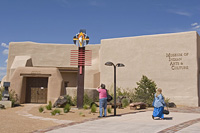 The M bus runs from the Plaza to Museum Hill, where four outstanding museums provide incentive to venture outside the city center. Two of these are part of the Museum of New Mexico.
The M bus runs from the Plaza to Museum Hill, where four outstanding museums provide incentive to venture outside the city center. Two of these are part of the Museum of New Mexico.
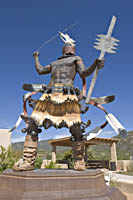 I didn’t have nearly enough time to spend at the Museum of Indian Arts and Culture (MIAC) and Laboratory of Anthropology. Between them, they contain the most comprehensive collection of Southwestern anthropological artifacts in existence including over 10 million artifacts from over 12,000 archeological sites across New Mexico as well as Native American artifacts from across North America. Of course, only a fraction of these are displayed in the permanent and temporary museum exhibits. The MIAC also has touring exhibits and online exhibits that can be accessed from their web site.
I didn’t have nearly enough time to spend at the Museum of Indian Arts and Culture (MIAC) and Laboratory of Anthropology. Between them, they contain the most comprehensive collection of Southwestern anthropological artifacts in existence including over 10 million artifacts from over 12,000 archeological sites across New Mexico as well as Native American artifacts from across North America. Of course, only a fraction of these are displayed in the permanent and temporary museum exhibits. The MIAC also has touring exhibits and online exhibits that can be accessed from their web site.
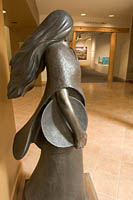 The experiential exhibit, Here, Now and Always, uses the voices of fifty Native Americans to guide visitors through their diverse communities and histories. Narrative, poems and songs give life to the 1300 artifacts of daily life displayed in environmental context.
The experiential exhibit, Here, Now and Always, uses the voices of fifty Native Americans to guide visitors through their diverse communities and histories. Narrative, poems and songs give life to the 1300 artifacts of daily life displayed in environmental context.
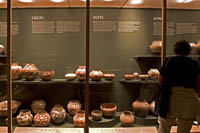 In the Buchsbaum Gallery of Southwestern Pottery nearly 300 pieces of Pueblo pottery are on display. Some of the earliest known pieces are on display, as well as the work of living Pueblo potters continuing the coiled pottery tradition.
In the Buchsbaum Gallery of Southwestern Pottery nearly 300 pieces of Pueblo pottery are on display. Some of the earliest known pieces are on display, as well as the work of living Pueblo potters continuing the coiled pottery tradition.
Temporary exhibits include the Pottery of Santa Ana Pueblo on display through September 2006. The collection tracks the development of the unique pottery style of this lesser-known Keres-speaking Pueblo north of Albuquerque.
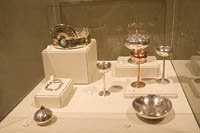 The work of 20 th century Cochiti silversmith Joe H. Quintana from the collection of Irma Bailey is on display through September 1, 2005. Items include intricate silver and turquoise jewelry, goblets, boxes and even a silver and turquoise dog collar that Quintana made for Bailey’s dog.
The work of 20 th century Cochiti silversmith Joe H. Quintana from the collection of Irma Bailey is on display through September 1, 2005. Items include intricate silver and turquoise jewelry, goblets, boxes and even a silver and turquoise dog collar that Quintana made for Bailey’s dog.
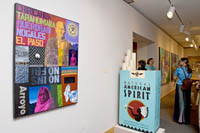 Through January 16, 2006, Iconoclashshows the work of David Bradley (Minnesota Chippewa) and Marcus Amerman (Choctaw). Both artists use painting and sculpture to satirize the way that mainstream American culture trivializes Native American people and culture by creating one-dimensional icons and labels.
Through January 16, 2006, Iconoclashshows the work of David Bradley (Minnesota Chippewa) and Marcus Amerman (Choctaw). Both artists use painting and sculpture to satirize the way that mainstream American culture trivializes Native American people and culture by creating one-dimensional icons and labels.
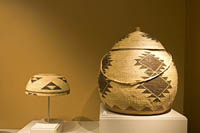 In the new Masterpieces Gallery, Beauty Within shows the artistry of 100 practical Native American objects including a Chilkat blanket from the Northwest coast, painted pre-Columbian pots, intricate basketry, embroidered and beaded clothing, clay figurines and two exquisite black on black pots by famed San Ildefonso potter Maria Martinez. Beauty within closes October 23, 2005.
In the new Masterpieces Gallery, Beauty Within shows the artistry of 100 practical Native American objects including a Chilkat blanket from the Northwest coast, painted pre-Columbian pots, intricate basketry, embroidered and beaded clothing, clay figurines and two exquisite black on black pots by famed San Ildefonso potter Maria Martinez. Beauty within closes October 23, 2005.
The pilgrimage to the Museum of New Mexico continues: Museum of Fine Arts, the Museum of International Folk Arts.and The Palace of the Governors
For additional information including online exhibits, visit www.miaclab.org.

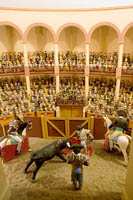 The Girard Wing contains a small sample of the 100,000 pieces donated by famed architect and designer Alexander Girard, who also designed the exhibit, Multiple Visions: A Common Bond, which is the definition of delightful. 10,000 colorful folk-art figures that he and his wife collected from 100 different countries on six continents are displayed in a context of miniature rooms, houses, churches, castles, villages and towns. Each display is a treat to behold. Hundreds of tiny spectators watch a bullfight in “Plaza de Toros”. Musicians play and uniformed cavalry ride as dozens of miniature pilgrims climb a long staircase in a display of 1930s decorative ceramics by Ana Das Telas and three other women from Estremoz, Portugal.
The Girard Wing contains a small sample of the 100,000 pieces donated by famed architect and designer Alexander Girard, who also designed the exhibit, Multiple Visions: A Common Bond, which is the definition of delightful. 10,000 colorful folk-art figures that he and his wife collected from 100 different countries on six continents are displayed in a context of miniature rooms, houses, churches, castles, villages and towns. Each display is a treat to behold. Hundreds of tiny spectators watch a bullfight in “Plaza de Toros”. Musicians play and uniformed cavalry ride as dozens of miniature pilgrims climb a long staircase in a display of 1930s decorative ceramics by Ana Das Telas and three other women from Estremoz, Portugal.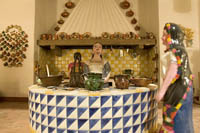 Women in Mexican garb make tiny enchiladas on a horseshoe shaped counter in a kitchen filled with miniscule clay pots, tin utensils and copper pans hanging above the brazero fireplace. Girard created the display based on a colonial kitchen he had seen in Mexico. A door off of the kitchen leads to a sala where a man plays a violin and light shines in from an interior courtyard.
Women in Mexican garb make tiny enchiladas on a horseshoe shaped counter in a kitchen filled with miniscule clay pots, tin utensils and copper pans hanging above the brazero fireplace. Girard created the display based on a colonial kitchen he had seen in Mexico. A door off of the kitchen leads to a sala where a man plays a violin and light shines in from an interior courtyard.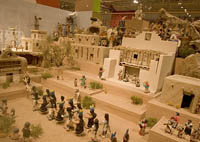 In “Pueblo Feast Day,” children play among adobe houses and tourists take photos as adult figures dance the corn dance below with kachina spirit dancers and eagle dancers on the mesa above. This exhibit contains the most famous piece of art in the gallery. Helen Cordero, a Cochiti Indian and Alexander Girard collaborated on the design of the first “storyteller” figure created by a New Mexico Pueblo artist. “Storyteller” figures of a seated woman with multiple children sitting or climbing on her have become ubiquitous in earthenware work.
In “Pueblo Feast Day,” children play among adobe houses and tourists take photos as adult figures dance the corn dance below with kachina spirit dancers and eagle dancers on the mesa above. This exhibit contains the most famous piece of art in the gallery. Helen Cordero, a Cochiti Indian and Alexander Girard collaborated on the design of the first “storyteller” figure created by a New Mexico Pueblo artist. “Storyteller” figures of a seated woman with multiple children sitting or climbing on her have become ubiquitous in earthenware work.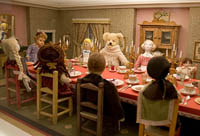 In “Doll’s Christmas Lunch” a teddy bear in a turtleneck and a couple pilgrims sit down to a fancy dinner with the other assorted interntaional residents of a Victorian doll house. East Indian puppets from Rajastan with black beards and mustaches painted on their carved wooden heads mingle with various Hindu gods and mythological figures in and around a multi-storied palace in “Indian Street Scene.” The marionettes are draped in elaborate gilded costumes.
In “Doll’s Christmas Lunch” a teddy bear in a turtleneck and a couple pilgrims sit down to a fancy dinner with the other assorted interntaional residents of a Victorian doll house. East Indian puppets from Rajastan with black beards and mustaches painted on their carved wooden heads mingle with various Hindu gods and mythological figures in and around a multi-storied palace in “Indian Street Scene.” The marionettes are draped in elaborate gilded costumes.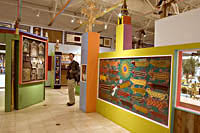 These vibrant daily-life and story-book scenes are interspersed with displays of masks, toys, paintings, costumes, ornate woven story panels and other colorful textiles, providing a constant flow of eye-candy. There are no captions on the displays, so be sure to pick up the spiral-bound guide to the Girard exhibit available at the entrance to be able to identify specific displays.
These vibrant daily-life and story-book scenes are interspersed with displays of masks, toys, paintings, costumes, ornate woven story panels and other colorful textiles, providing a constant flow of eye-candy. There are no captions on the displays, so be sure to pick up the spiral-bound guide to the Girard exhibit available at the entrance to be able to identify specific displays.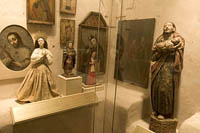 Another permanent exhibit is the Familia y Fe/Family and Faith exhibit in the Hispanic Heritage Wing. The exhibit features pieces from the Museum’s New Mexico Hispanic folk art collection including religious and household objects. The artistry of furniture making and woven textiles are juxtaposed with the religious retablos (paintings) andbultos (wooden sculptures) that have been used both in the home and for ceremonial purposes since the 17 th century.
Another permanent exhibit is the Familia y Fe/Family and Faith exhibit in the Hispanic Heritage Wing. The exhibit features pieces from the Museum’s New Mexico Hispanic folk art collection including religious and household objects. The artistry of furniture making and woven textiles are juxtaposed with the religious retablos (paintings) andbultos (wooden sculptures) that have been used both in the home and for ceremonial purposes since the 17 th century.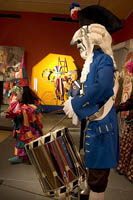 Through August 2005, the Museum is hosting the traveling exhibit ĄCARNAVAL! About 50 festively costumed manikins step out of life-size photos representing select carnival traditions of Bolivia, Brazil, Italy, Mexico, Spain, Switzerland, Trinidad and Tobago and the USA. Accompanying video clips of the each celebration bring the tableaus alive.
Through August 2005, the Museum is hosting the traveling exhibit ĄCARNAVAL! About 50 festively costumed manikins step out of life-size photos representing select carnival traditions of Bolivia, Brazil, Italy, Mexico, Spain, Switzerland, Trinidad and Tobago and the USA. Accompanying video clips of the each celebration bring the tableaus alive.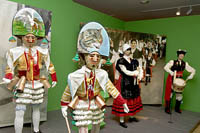 and entertainment organizations are hosting a variety of carnival-themed events throughout the exhibit. Highlights include a Brazilian entertainment weekend at the Museum June 25-26, a Swiss Carnival weekend July 23-24 and a Mexican weekend August 13-14. For more related events including music, arts and crafts workshops and cooking classes visit
and entertainment organizations are hosting a variety of carnival-themed events throughout the exhibit. Highlights include a Brazilian entertainment weekend at the Museum June 25-26, a Swiss Carnival weekend July 23-24 and a Mexican weekend August 13-14. For more related events including music, arts and crafts workshops and cooking classes visit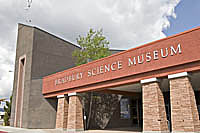 Whether you’re pro or anti, the history of the secret community of scientists who gathered in Los Alamos New Mexico during WWII to develop the first atomic bomb can’t help but fascinate. About 35 miles up the mountain from Santa Fe, the Los Alamos National Laboratory is still on the cutting edge of scientific research. The Lab isn’t generally open to the public, but the Bradbury Science Museum in the town of Los Alamos gives an overview of the Lab’s history and its current research.
Whether you’re pro or anti, the history of the secret community of scientists who gathered in Los Alamos New Mexico during WWII to develop the first atomic bomb can’t help but fascinate. About 35 miles up the mountain from Santa Fe, the Los Alamos National Laboratory is still on the cutting edge of scientific research. The Lab isn’t generally open to the public, but the Bradbury Science Museum in the town of Los Alamos gives an overview of the Lab’s history and its current research.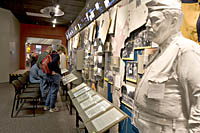 A short video gives the history of the creation of the National Science Laboratory during WWII and another on its current research. A History Gallery provides additional documents, photos, and videos on the Manhattan Project, the scientists involved and life in the secret scientific community that went nameless until after the war.
A short video gives the history of the creation of the National Science Laboratory during WWII and another on its current research. A History Gallery provides additional documents, photos, and videos on the Manhattan Project, the scientists involved and life in the secret scientific community that went nameless until after the war.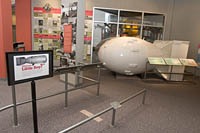 The Defense Gallery focuses on the National Security functions of the Lab and what it does to ensure the safety of existing “nuclear deterrents.” This exhibit has a “Fat Man” bomb casing identical to the one dropped on Nagasaki as well as various other missile casings. There is also an exhibit about where plutonium comes from, its risks and what measures are taken to dispose of it safely. There are a variety of interactive exhibits, including a biometric security turnstile, where you can scan an ID card (provided) and use your hand print to get through the security gate.
The Defense Gallery focuses on the National Security functions of the Lab and what it does to ensure the safety of existing “nuclear deterrents.” This exhibit has a “Fat Man” bomb casing identical to the one dropped on Nagasaki as well as various other missile casings. There is also an exhibit about where plutonium comes from, its risks and what measures are taken to dispose of it safely. There are a variety of interactive exhibits, including a biometric security turnstile, where you can scan an ID card (provided) and use your hand print to get through the security gate.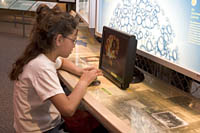 In the Research Gallery, you can learn about the human genome, space science research, radiation, lasers and other ongoing Laboratory research. The exhibits are designed for school-age children through adults. Admission is free. Many of the exhibits are interactive.
In the Research Gallery, you can learn about the human genome, space science research, radiation, lasers and other ongoing Laboratory research. The exhibits are designed for school-age children through adults. Admission is free. Many of the exhibits are interactive.